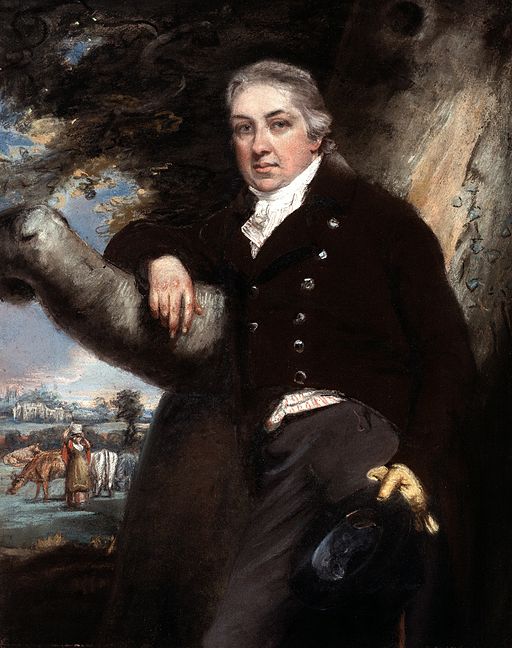Edward Jenner conducts his first Inoculation against smallpox
- May 14th 1796 -
 May 14th 1796, Dr. Edward Jenner administered the first inoculation against the deadly disease, smallpox.
May 14th 1796, Dr. Edward Jenner administered the first inoculation against the deadly disease, smallpox.
Smallpox was the greatest killer of Jenner's time and feared by the population but actually it was a very ancient disease. When the mummified body of the Pharaoh Ramases V, who died in 1157BC, was discovered, he was found to have scars believed to have been caused by smallpox. It is spread through saliva and close contact with people. A rash forms that shows up as blisters that fill with pus, or fluid, also known as pocks, from which it gets its name.
The disease spread rapidly through Europe and was carried to the Americas via the voyages of discovery that were taking place at that time. The Spanish success against both the Aztecs and Incas was helped by the fact that both these tribes had no natural immunity and it killed them in huge numbers. The disease also decimated the Aborigines when it reached Australia.
Smallpox had no boundaries. During the latter years of the eighteenth century around 400,000 Europeans were dying annually, including 5 reigning monarchs. Prince William, who was Queen Anne's heir, died from the disease at the age of 11, which altered the succession of the British royal family. George Washington, Abraham Lincoln, Elizabeth 1 and Mozart were all notable sufferers of smallpox who survived the disease but were left with the telltale-pockmarked skin.
In the 20thCentury alone over 300 million died of this disease. The last case of naturally occurring smallpox was in Somalia in 1977 but three years later the World Health Organisation declared that the world was free of the disease.
It was in the 1720s that the wife of the British Ambassador in Istanbul, Lady Mary Wortley Montagu, brought the idea of inoculation to Britain. Herself a survivor of smallpox, she had seen the process carried out in Turkey and inoculated her own children as well as persuading the Princess of Wales to do the same to hers.
Edward Jenner himself, born on 17thMay 1796, was the son of a vicar who died when he was just 5. He was brought up by his mother, 2 brothers and 3 sisters. He loved to wander in the fields near Berkeley, Gloucestershire, where he lived and was very interested in animals, nature, plants and fossils. Aged 14 he was apprenticed to a local surgeon and then trained in London, returning to Berkeley as a doctor in 1777, where he spent most of the rest of his life. He married Catharine Kingscote, in 1788 after meeting her when a balloon he was experimenting with descended into the gardens of her father, Anthony, the owner of Kingscote Park, Gloucestershire. They had 3 children; two boys and a girl but she tragically died in 1815 from tuberculosis. He then semi-retired, preferring to look instead for fossils.
It was while talking to some milkmaids about smallpox when they mentioned that they never got the disease because they always got cowpox first. The idea of a vaccination occurred to him. Jenner first experimented on 8-year-old James Phipps, the son of his gardener in 1797. He took a small amount of a cowpox pustule from milkmaid Sarah Nelmes, made an incision in the boy’s arm and wiped the infection into his system. James developed cowpox and 8 weeks later Jenner gave him a very small dose of smallpox. He never developed the illness.
Later that year he wrote to the Royal Society with his findings but they felt that his theory was far too radical and he needed more proof. He was ridiculed in the press too and by the Church, who said it was ungodly to insert anyone with the diseased material of an animal. Not to be put off he experimented on his own 11-month-old son, amongst others, and in 1798 he published his results. They were compelling. He called his inoculation a ‘Vaccine’ from the Latin word for a cow – vacca – a term that was to be taken on by the medical profession across the world. He vaccinated hundreds for free in Berkeley from a hut in his garden and a further 200 in one day in Petworth, Sussex. He became one of the most famous doctors in the world. Even Emperor Napoleon released some English prisoners at his behest saying that, “He could refuse Jenner nothing.”
Edward Jenner died on January 26th1823. In 2002 he was named 78thin the list of the most famous Britons – far too low many would argue. His house in Berkeley is now a museum, which contains the horns of the cow, Blossom, from which Sarah Nelmes caught cowpox. There is a statue of him in Gloucester Cathedral and there was one in Trafalgar Square before it was moved to Kensington Gardens. You can also find the Jenner pavilion in St George’s Medical School, in London as well as many hospital wards named in his honour.
The world owes Edward Jenner an enormous amount. He was the forerunner and pioneer of immunology that has seen millions, possibly billions, saved from illness and disease.


